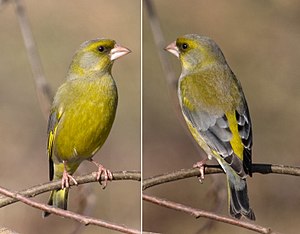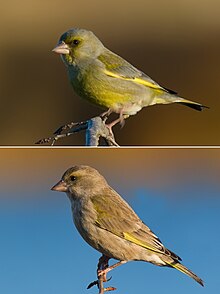Greenfinch
| Greenfinch | ||||||||||||
|---|---|---|---|---|---|---|---|---|---|---|---|---|

Male greenfinch ( Chloris chloris ) |
||||||||||||
| Systematics | ||||||||||||
|
||||||||||||
| Scientific name | ||||||||||||
| Chloris chloris | ||||||||||||
| ( Linnaeus , 1758) |
The greenfinch ( Chloris chloris , Syn .: Carduelis chloris ), also known as greenfinch , is a bird from the goldfinch subfamily in the finch family , native to all of Europe , northern Africa and southwestern Asia . The vast majority of greenfinches are resident birds , but some of the more northern populations migrate to western and southern Europe in winter.
features
With a length of 14 to 16 cm, the greenfinch is about the same size as the house sparrow . The body, head and beak are remarkably strong. The beak is brightly horn-colored. The outer flags of the hand wings are yellow, resulting in a green-yellow wing field. When the wing is folded, the outer edge is also clearly yellow. The parts of the tail feathers close to the body are also yellow.
The male is yellow-green on the underside of the body and gray-green on the top. The rump is lighter green. The cheeks, throat, nape and large elytra are gray, the flanks are light gray. On the wings there is a gray wing field in the area of the arm wings . The tips of the large plumage are dark. The throat is dirty yellow. The legs are flesh-colored.
The female is overall much more dull and less yellow in color than the male. The entire body fletching is weakly dashed lengthways. Their top and head are brownish, the underside of the trunk is pale greenish-gray in color. The throat is light, the cheeks brown.
The youth dress is clearly lighter, the underside of the body is whitish with light gray vertical stripes, the upper side is washed out gray-brown and slightly striped lengthways. The yellow color of the wing is very indistinct. There is a pale gray area around the eye. The large elytra have wide, beige-colored end hems. The legs of females and young birds are dark sand-colored. The iris is dark in all of them.
voice
The call of the greenfinch is a short, powerful "jüpp" that is usually repeated in quick series. It is also stepped up to a short trill that sounds something like "djüp-rüp-rüp". The call can also sound like "juÍT".
The singing occurs in two very different types. A non-musical, vibrating and croaking sound that sounds like “dschrüüüüjuh” (like the sound when winding a wrist or pocket watch - which is why the bird is nicknamed "watchmaker"), which is repeated with long pauses. The other type ( ) is more pleasant, elongated and resembles that of the canary . It consists of trills, whistles and rapid chirping and sounds like "djüpp-djüpp-djüpp djürrrrrrrr tuj-tuj-tuj duÍT tjipp-tjipp-tjipp-tjipp dürdürdürdür djürrrrrrrr" or something similar. Sometimes both types of singing are mixed up.
distribution and habitat
distribution
The original distribution area includes Europe , North Africa and West Asia . The northern limit of the distribution area runs from the 65th parallel in Scandinavia through central Finland to Lake Ladoga and up to about 60th parallel in the Urals . In the Maghreb, the southern border roughly follows the northern edge of the Sahara to the coasts of the eastern Mediterranean. The western border is formed by the British Isles , the Iberian Peninsula and Morocco . In the east the distribution area extends to the Urals, the Caucasus and the southern coasts of the Caspian Sea . In Central Asia there is a small, isolated sub-area. The green body is considered naturalized in the Azores , Canary Islands and Madeira . In the southern hemisphere, it is naturalized in Uruguay , Argentina , Australia and New Zealand .
habitat
The greenfinch is originally a resident of sparse trees, clearings or open areas that border on the edges of the forest, as well as riparian and field trees. Today it mainly populates the most diverse forms of human settlement: From individual farms and hamlets with orchards to large city centers with parks or cemeteries, provided that there are at least individual trees, rows of trees or green house facades.
Reproduction
The species breeds from April to June. The bowl-shaped nest made of stalks and stalks with a soft nest hollow can be found in hedges and thick bushes. The clutch consists of 5–6 whitish eggs with dark brown spots and spots. While only the female hatches the eggs in 13-14 days, both parents feed the nestlings. The diet consists mainly of berries, buds and seeds.
Young birds are fed by the male
Duration
The population in Germany is estimated at 1.7 to 2.6 million pairs. In 2008 the species is in 13th position in the list of common breeding bird species. The green compact is listed as "not endangered" in the IUCN Red List .
Systematics
External system
For a long time, the greenfinches were classified in the genus Carduelis . However, based on phylogenetic studies from 2012, this taxon was divided into a larger number of genera. Since then, the greenfinch and its closely related greenling species have been listed in the genus Chloris .
The closely related species of the genus Chloris are:
- the black-headed greenfinch ( Chloris ambigua )
- the Chinese finch ( Chloris sinica )
- the Vietnamese greenfinch ( Chloris monguilloti )
- the Himalayan finch ( Chloris spinoides )
Internal system
A total of ten subspecies are distinguished:
- C. c. harrisoni Clancey , 1940 - Great Britain (excluding Northern Scotland) and Ireland
- C. c. chloris ( Linnaeus , 1758) - northern Scotland, northern and central France to western Siberia
- C. c. muehlei Parrot , 1905 - Serbia and Montenegro to Moldova , Bulgaria and Greece
- C. c. aurantiiventris ( Cabanis , 1851) - southern Spain to western Greece
- C. c. madaraszi Tschusi , 1911 - Corsica and Sardinia
- C. c. vanmarli Voous , 1952 - Northwest Spain, Portugal and Northwest Morocco
- C. c. voousi ( Roselaar , 1993) - Central Morocco and Northern Algeria
- C. c. chlorotica ( Bonaparte , 1850) - southern Turkey to northeast Egypt
- C. c. bilkevitchi Zarudny , 1911 - southern Ukraine , the Caucasus and northeastern Turkey to northern Iran and southwestern Turkmenistan
- C. c. turkestanica Zarudny, 1907 - southern Kazakhstan to Kyrgyzstan and central Tajikistan
Greenfinches die in 2009
Since the beginning of May 2009, massive deaths of green finches as a result of Trichomonadosis , an infection with the single-cell Trichomonas gallinae , have been observed in northern Germany . According to NABU estimates, tens of thousands of birds died from this disease across Germany.
As a source of trichomonads infection, in addition to direct contact between the animals, drinking water at feeding places, in which the pathogen can survive for up to 24 hours, comes into question. The risk of disease transmission is particularly great at such gathering points for the birds. In July 2009 NABU therefore called on people not to feed wild birds and to remove bird baths from the garden for the time being.
Symptoms of the disease are primarily strong fluffiness, lethargic behavior (the bird looks apathetic or sleepy, sometimes short of breath), a lack of escape reflex, as well as difficulty swallowing or a sticky beak. The animals then die within a short time. A successful drug treatment of sick animals is not possible.
supporting documents
literature
- UN Glutz von Blotzheim , KM Bauer : Handbook of the birds of Central Europe . (HBV). Volume 14-II: Passeriformes. (5th part), Aula, Wiesbaden 1997, ISBN 3-923527-00-4 .
- Lars Svensson , PJ Grant, K. Mullarney, D. Zetterström: The new cosmos bird guide - all species of Europe, North Africa and the Middle East. Franckh-Kosmos-Verlags-GmbH & Co., Stuttgart, 1999, ISBN 3-440-07720-9 .
Web links
- Chloris chloris in the endangered Red List species the IUCN 2017. Posted by: BirdLife International, 2016. Accessed January 25, 2018th
- Videos, photos and sound recordings of Chloris chloris in the Internet Bird Collection
- Entry at the Swiss Ornithological Institute
- Feathers of the greenfinch
Individual evidence
- ↑ HBV Volume 14/2, C. chloris. Distribution of the art. Pp. 543-545, see literature.
- ↑ HBV Volume 14/2, C. chloris. Distribution of the art. Pp. 570-571, see literature.
- ↑ cf. Sudfeldt, C., R. Dröschmeister, C. Grüneberg, S. Jaehne, A. Mitschke & J. Wahl: Birds in Germany - 2008. DDA, BfN, LAG VSW, Münster 2008, page 7 full text, PDF .
- ↑ D. Zuccon, R. Prŷs-Jones, P. Rasmussen and P. Ericson: The phylogenetic relationships and generis Limits of finches (Fringillidae) . In: Molecular Phylogenetics and Evolution . tape 62 , no. 2 , February 2012, p. 581-596 , doi : 10.1016 / j.ympev.2011.10.002 ( nrm.se [PDF]).
- ↑ F.Gill, D. Donsker: Finches, euphonies. In: World Bird List Version 5.2. International Ornithologists' Union, accessed June 5, 2015 .
- ^ NABU - Naturschutzbund Deutschland eV [1]
- ↑ NABU Braunschweig [2]











